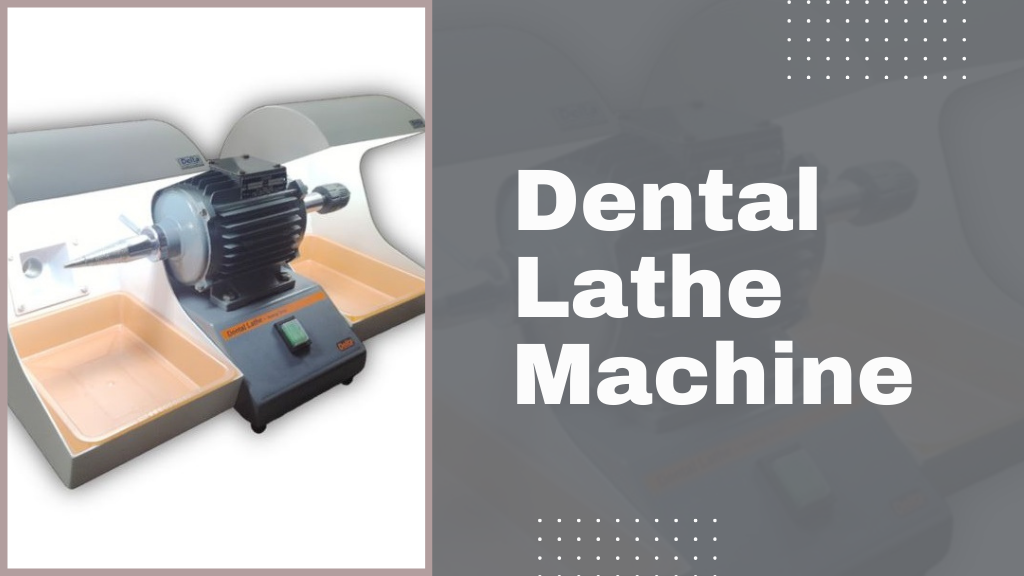In the modern dental industry, precision and efficiency are crucial. One tool that stands out for its role in dental laboratories is the dental lathe machine. From polishing dentures to shaping dental prosthetics, these machines are indispensable for dental technicians and professionals seeking accurate results. This guide explores everything you need to know about dental lathe machines, their applications, features, and selection tips.
What is a Dental Lathe Machine?
A dental lathe machine is a rotary device used primarily in dental labs to polish, grind, and shape dental appliances such as dentures, crowns, and bridges. The machine works by spinning various attachments at high speeds, allowing precise manipulation of materials including acrylics, metals, and ceramics.
Dental lathes are not only used for finishing dental prosthetics but also for trimming, buffing, and even minor adjustments during the fabrication process. Their versatility makes them essential equipment in dental laboratories worldwide.
Key Components of a Dental Lathe Machine
Understanding the parts of a dental lathe machine is essential for safe operation and efficient performance. Each component plays a specific role in grinding, polishing, or finishing dental materials. Knowing how they work together helps maximize precision and reduce the risk of accidents.
-
Motor
The motor powers the spindle and usually ranges from 1/8 HP to 1/3 HP. It provides the necessary torque to rotate tools at different speeds. A strong, reliable motor ensures consistent performance during prolonged use.
-
Spindle
The spindle rotates at adjustable speeds to accommodate various materials and tasks. It is the central component that drives the rotation of tools and attachments. Proper spindle maintenance is key to accuracy and smooth operation.
-
Tool Rest
The tool rest provides stable support for tools during grinding or polishing. Correct positioning reduces strain on the operator and ensures precise shaping of dental components. Adjustable rests allow versatility for different tasks.
-
Handpiece
Some dental lathe models include a handpiece attachment for detailed or precision work. This allows for finer control on small or intricate dental components. It is especially useful for delicate finishing tasks.
-
Safety Shield
The safety shield protects the operator from flying debris, dust, and accidental contact with moving parts. Always ensure the shield is properly positioned before starting the lathe. This simple step greatly reduces the risk of injury.
-
Base
The base provides stability to the machine and helps reduce vibration during operation. A solid, well-designed base ensures smoother performance and improves control over delicate workpieces. Proper placement of the lathe on a stable surface is essential.
Types of Dental Lathe Machine
Dental lathes are available in various designs, each suited for specific tasks in dental labs. Choosing the right type depends on the work volume, precision requirements, and the size of the components being handled. Understanding the differences helps optimize efficiency and accuracy.
-
Bench Lathes
Bench lathes are compact machines designed to sit on workbenches. They are ideal for small dental labs or hobbyists. Their portability and user-friendly design make them perfect for everyday tasks and lighter workloads.
-
Floor Lathes
Floor lathes are larger, more powerful machines built for high-volume dental labs. They can handle heavier materials and provide greater stability during operation. These lathes are ideal for extended use and demanding tasks.
-
High-Speed Lathes
High-speed dental lathes are designed for intricate detailing and precise finishing. They excel at polishing and shaping crowns, bridges, and other delicate prosthetics. Their speed and accuracy make them essential for detailed work.
-
Micro-Lathes
Micro-lathes are specialized machines used for precision tasks. They are perfect for adjusting orthodontic appliances or working on fine dental components. These lathes offer high control and accuracy for miniature workpieces.
Applications of a Dental Lathe Machine
Dental lathe machines are versatile tools that serve multiple functions in dental laboratories. They help technicians achieve precision, improve efficiency, and maintain high-quality standards for dental work. Their applications range from shaping and polishing to fine adjustments on various dental components.
1. Polishing Dentures
Dental lathes are used to polish dentures, creating smooth and natural-looking surfaces. Proper polishing enhances comfort for the patient and improves the aesthetic appearance of the prosthetic.
2. Shaping Crowns and Bridges
Lathes help shape crowns and bridges to ensure a perfect fit and finish. Accurate shaping prevents discomfort and ensures that restorations function correctly in the patient’s mouth.
3. Adjusting Orthodontic Appliances
Technicians use dental lathes to fine-tune orthodontic appliances such as aligners and retainers. Precision adjustments improve effectiveness and reduce the need for repeated fittings.
4. Buffing Metals and Ceramics
Dental lathes are also used to buff metals and ceramics, preparing them for lab use or patient delivery. This process ensures smooth edges, proper shape, and a polished finish on all materials.
5. Repairing Dental Prosthetics
Minor modifications and repairs to dental prosthetics can be done using a lathe. This avoids complete remanufacturing, saving time and materials while maintaining high-quality results.
Real-World Example: At Smith Dental Lab, technicians reported that using a high-speed dental lathe reduced polishing time by 40%, significantly improving overall lab productivity.
How to Choose the Right Dental Lathe Machine
Selecting the ideal dental lathe depends on the size of your lab, budget, and the types of tasks you perform. Evaluating key features ensures you get a machine that meets your operational needs while maintaining safety and efficiency.
-
Speed Control
Variable speed control is essential for adapting to different materials and tasks. Lower speeds are ideal for acrylics to prevent overheating, while higher speeds improve efficiency when working with metals. Having precise control enhances accuracy and protects your workpieces.
-
Motor Power
The motor’s strength determines how well the lathe handles heavy-duty polishing and grinding. Small labs may find a 1/8 HP motor sufficient, but larger labs or more demanding tasks might require 1/3 HP or higher for consistent performance.
-
Attachments and Accessories
Consider which attachments and accessories come with the machine, such as buffing wheels, mandrels, and tool rests. Additional attachments increase versatility, allowing you to perform a wider range of tasks without buying extra equipment.
-
Safety Features
Safety features like protective shields and emergency shut-offs are crucial. They minimize the risk of accidents and ensure a safer work environment for lab technicians, especially during high-speed operations.
-
Noise and Vibration Levels
Machines with minimal vibration reduce hand fatigue and improve precision during detailed work. Low-noise motors also create a more comfortable lab environment, which can boost productivity and reduce strain on technicians.
Maintenance Tips for Dental Lathe Machine
Proper maintenance of a dental lathe machine ensures long-lasting performance and reliable operation. Regular attention to cleaning, lubrication, and inspection prevents breakdowns and maintains precision in dental work.
-
Regular Cleaning
After each use, remove dust, debris, and metal particles from the lathe. A clean machine prevents buildup that can affect performance and reduce the lifespan of components. Pay attention to the spindle, tool rest, and surrounding areas.
-
Lubrication
Keep all moving parts well-lubricated to prevent wear and friction. Proper lubrication ensures smooth operation and reduces the risk of overheating during extended use. Use manufacturer-recommended oils or greases.
-
Inspect Tools
Regularly check buffing wheels, handpieces, and other attachments for wear or damage. Replace any worn or broken parts immediately to maintain precision and avoid accidents. Proper tools improve both safety and results.
-
Check Electrical Components
Inspect cords, switches, and plugs for signs of damage or fraying. Ensuring all electrical components are intact reduces the risk of short circuits or malfunctions and keeps the lathe safe to operate.
-
Follow Manufacturer Guidelines
Always follow the maintenance and operation instructions provided by the manufacturer. Adhering to model-specific guidelines ensures optimal performance and prevents voiding warranties or causing damage.
Advantages of Using a Dental Lathe Machine
Dental lathes offer several benefits that make them essential tools in modern dental laboratories. They improve workflow, enhance precision, and ensure high-quality results for a variety of dental applications.
1. Precision
The high-speed rotation of a dental lathe allows for fine detailing on dental components. This precision ensures accurate shaping, fitting, and finishing of crowns, bridges, dentures, and orthodontic appliances.
2. Efficiency
Using a dental lathe reduces manual effort and speeds up lab work. Tasks that would take considerable time by hand, such as polishing or shaping, can be completed much faster with consistent results.
3. Versatility
Dental lathes can work with multiple materials, including metals, acrylics, and ceramics. This versatility makes them suitable for a wide range of applications, from prosthetic fabrication to appliance adjustment.
4. Cost-Effective
By allowing precise adjustments, dental lathes minimize material waste. They also reduce the need for rework, helping labs save time and money while maintaining high standards.
5. Professional Finish
A dental lathe produces smooth, polished surfaces, enhancing the appearance and quality of dental work. This professional finish contributes to greater patient satisfaction and overall lab reputation.
Common Challenges and How to Overcome Them
Dental lathes, while highly effective, can present certain challenges that affect efficiency and safety. Being aware of these issues and applying the right solutions helps maintain smooth operation and extend the machine’s lifespan.
-
Overheating
Excessive friction during operation can damage both the workpiece and the machine. To prevent overheating, use variable speed settings appropriate for the material and apply proper cooling techniques when necessary.
-
Wear and Tear of Accessories
Buffing wheels, mandrels, and other attachments naturally degrade over time. Regular inspection and timely replacement of worn components ensure consistent performance and prevent damage to dental materials.
-
Operator Fatigue
Extended periods of use can strain the hands and wrists of technicians. Choosing ergonomic models with low vibration, along with regular breaks, helps reduce fatigue and maintain precision during detailed work.
-
Noise
High-speed dental lathes can generate significant noise, which may affect concentration and comfort. Opting for machines with built-in noise reduction or using appropriate ear protection can mitigate this issue effectively.
Innovations in Dental Lathe Machine
The dental industry is adopting modern technologies:
- Digital Integration: Some lathes connect to CAD/CAM systems for precise adjustments.
- Advanced Materials: Machines now handle newer ceramics and high-strength polymers.
- Eco-friendly Motors: Energy-efficient motors reduce power consumption.
- Enhanced Safety Features: Automatic shut-offs and enclosed shields prevent accidents.
Tips for Safe Operation
Safety is paramount in dental labs:
- Wear protective eyewear and masks.
- Secure loose clothing and hair.
- Use tool rests to stabilize materials.
- Avoid overloading the machine.
- Follow all manufacturer guidelines for setup and use.
Top Brands and Models
Some of the leading dental lathe machine providers include:
- DuraPro Health: Offers bench and high-speed lathes suitable for small and medium labs. Rated 4.8 stars on Google Reviews.
- Handler Manufacturing: Known for durable and ergonomic machines. Their starter guide is a helpful resource for beginners.
- Bego and KaVo: Premium models with advanced safety features and high-speed performance.
These brands are widely used in professional dental labs, providing reliability and consistent results.
How Dental Lathe Machine Improve Lab Productivity
By streamlining tasks like polishing and shaping, dental lathes allow technicians to focus on precision and quality. For instance:
- Denture finishing time is reduced by up to 40%.
- Crowns and bridges are completed faster with fewer adjustments.
- Errors due to manual grinding are minimized.
A well-equipped lab with dental lathes can handle more clients, increase revenue, and maintain high-quality standards.
Conclusion
The dental lathe machine is a cornerstone of modern dental laboratories. Its precision, versatility, and efficiency make it an essential investment for dental technicians and professionals. From polishing dentures to shaping crowns, these machines enhance productivity while ensuring high-quality results.
When choosing a dental lathe, consider motor power, speed control, safety features, and brand reliability. Proper maintenance and safe operation will extend the machine’s lifespan and maximize its performance.
For professionals seeking to upgrade their lab equipment, a dental lathe is not just a tool, it’s a pathway to better quality, faster production, and improved patient satisfaction.
FAQs
What is the ideal speed for a dental lathe machine?
Most dental lathes offer variable speeds ranging from 3,000 to 20,000 RPM. Acrylic materials require lower speeds, while metals and ceramics benefit from higher speeds.
Can I use a dental lathe at home?
Dental lathes are designed for professional labs. Using them at home is not recommended due to safety risks and material handling requirements.
How long does a dental lathe machine last?
With proper maintenance, a high-quality dental lathe can last 5–10 years or more, depending on usage frequency.
Are dental lathes suitable for all dental materials?
Yes, but it’s important to select the right speed, motor, and attachments for each material type.
Where can I buy a reliable dental lathe machine?
Reputable sources include Handler Manufacturing, DuraPro Health, and verified distributors on IndiaMART. Always check for warranty and reviews before purchase.




